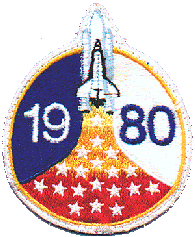

The First Design
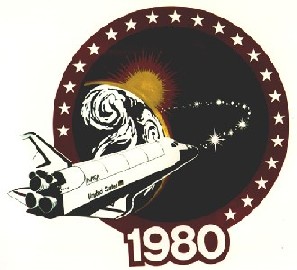
..."Our ASCAN patch was the second patch designed for the class. The first patch looks like the Orbiter is flying into the patch. (see photo below) You will note that there are 21 stars on it. In other words, it did have stars for Ockels and Nicollier. The patch went through all the required approval cycles at JSC and was sent to NASA Headquarters for final approval. After being reviewed by the higher authorities in Washington it was disapproved. The explanation given was that it appeared that the Orbiter was firing a gun out of its nose. This was during the cold war and someone at headquarters felt that it made the Orbiter appear to be engaged in a warlike act. This really upset the class because it had been our choice and it had been cleared by (George)Abbey and (John)Young. It resulted in the second patch being designed. The reason it only had 19 stars on it was because Abbey and Young felt they had been politically pressured into accepting Ockels and Nicollier into the class and therefore they were only going to approve a patch for the class as it was originally constituted"...
The People
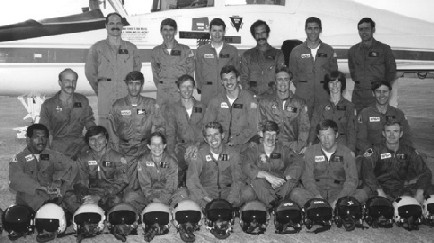
The 21 members of the 1980 astronaut class are:
James P. Bagian, John E. Blaha, Charles F. Bolden, Jr., Roy D. Bridges, Jr.,
Franklin R. Chang-Diaz, Mary L. Cleave, Bonnie J. Dunbar, William F. Fisher,
Guy S. Gardner, Ronald J. Grabe, David C. Hilmers, David C. Leestma,
John M. Lounge, Bryan D. O'Connor, Richard N. Richards, Jerry L. Ross,
Michael J. Smith, Sherwood C. Spring, Robert C. Springer. (+ European Space
Agency astronauts Claude Nicollier, Switzerland, & Wubbo Johannes Ockels,
the Netherlands)
The Artwork
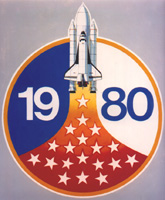
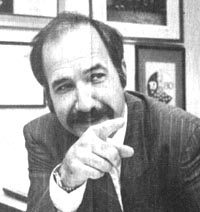
Shown here are NASA photograph S89-29025 and a newspaper photo of Dutch astronaut Wubbo Ockels in his office in 1990, the artwork visible on the wall behind him. (Groninger Gezinsbode, June 27, 1990). It looks like this is a "special" version, with two stars added under the "19" and "80".
..."The class was so ticked about all that had gone on, (with the change of patch design) that most of them refused to wear the patch. I can't recall having worn it on any of my clothing. I felt that all the stars flowing out the back end of the Orbiter made it look like the engines were all coming apart...
The picture of Wubbo in his office is very interesting because I can not recall any patches that had been created to add to two extra stars.
I think the artist who designed the patch (and the first design), was Bill Fisher. I do not know who the manufacturer for the patch was"...
Spot the patch !!!
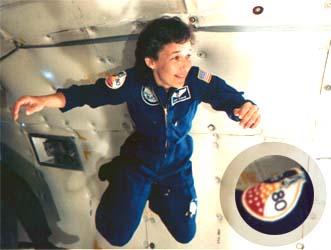
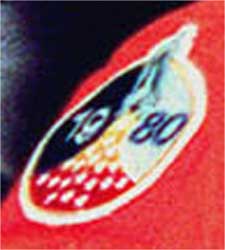
The patch shows up in a series of August 21, 1985 photographs, starring 61B astronauts
Jerry Ross and Mary Cleave floating aboard NASA's KC-135 aircraft.
Shown here (picture #1) is photo S85-39137. Note the original 51G patch (without Neri / Walker tab) and Mary's name tag, which is one of the first times that type of embroidered wings appeared in NASA photography.
The 1980 patch is rarely seen in public, but in December 1998, STS-88 crew member Jerry Ross could be seen wearing it on his orange launch and entry suit (picture #2).
Source / Availability
The 1980 astronaut class patch was probably made by Lion Brothers, AB Emblem or a local patch company. It was not made available to the public and is extremely rare. We got the patch from collector Donnis Willis, who in turn received it "from a lady who worked at the astronaut quarters at the Kennedy Space Center." We have never seen it offered anywhere else. There is a souvenir versions of the patch available - made by Randy Hunt - as you can see below.
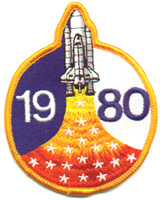
A Personal Story...
Here is an excerpt from a 1985 book in which Wubbo Ockels describes the moment when the 1980 class graduated:
"We were seated in an office with twenty one persons, waiting for the guy who would give us our certificates. It turned out to be John Young, the Chief Astronaut. He walked in - in his usual manner - looking straight ahead. ,,This is your day", he said. Things like that. Then he saw me.
,,Wubbo, I expected 19 people. You are number 20." I thought he was joking, but then he said: ,,No offence." I stood up and left. Claude Nicollier, who was also there, said: ,,Since I am number 21, I will leave as well." Things were straightened out the next day at the highest ESA and NASA levels."
Astronaut John Blaha telling about astronaut training:
Why did you become an astronaut?
I always wanted to fly airplanes. I grew up watching airplanes. Also I had a lot of model airplanes that I built and flew. At the Air Force Academy I started seeing spaceflight with the Mercury program. I thought, well I like to fly airplanes...one day I'd like to fly space vehicles. I can't think of any other trigger than these.
How long have you been in the astronaut training program?
I became an astronaut in 1980. I flew with six space shuttle crews and one Mir crew.
How did being a research pilot help prepare you for the astronaut corps?
I was taught as a research pilot to collect data and information. That was the same. I flew an F-104 airplane in 1971 and we completed a glided entry into the Edwards Air Force Base. I later realized that as a Space Shuttle pilot we were following the same profile, so I felt very at home 80,000 feet and down on the Shuttle.